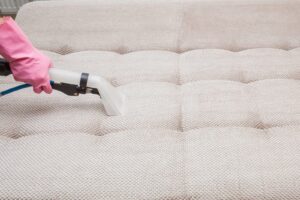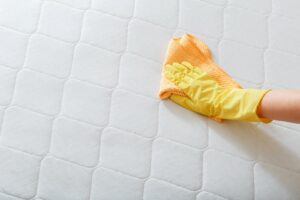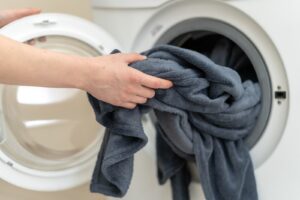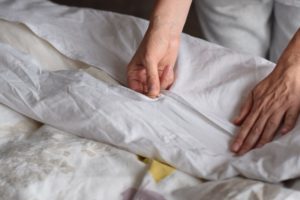How to Wash a Mattress Protector
Keep Your Bed Fresh and Clean
Mattress protectors are designed to keep dirt, allergens, and oftentimes liquid from reaching your mattress, but mattress protectors also get dirty themselves.
Washing a mattress protector may seem daunting, especially for waterproof protectors with polyurethane backing, but it’s relatively simple once you know the steps. Most mattress protectors are machine-washable, though it’s a good idea to check your protector’s tag for any special instructions.
We’ll cover everything you need to know about washing a mattress protector, including tips for both machine-washing and hand-washing. We’ll also explain how to remove tough stains and discuss how often you should wash your mattress protector.
Tips for Washing a Mattress Protector
Most mattress protectors can be machine-washed for simple care, but there are a few tips to keep in mind to help your mattress protector last. Check your product’s care label for specific instructions related to wash temperature, detergents, and drying.
What You Need
For the majority of mattress protectors, you’ll only need a few items for cleaning:
- A washing machine
- Detergent (a mild detergent, if recommended by the manufacturer)
- Stain remover
- A cleaning cloth or brush, if needed
- A dryer or clothesline
Read the Label
Read your mattress protector’s label for specific wash instructions. Often, the manufacturer lists the proper wash and dry temperatures and which wash cycle is best. The label might also indicate if you should use special detergents or stain removers.
And if you’ve removed your label, you can usually find care instructions on the brand’s website.
Treat Any Stains
It’s a good idea to check for stains before you wash your mattress protector, so you don’t accidentally set the stains in the dryer.
Rinse stains in cold water to help lift them. Then, apply a stain remover and let it sit for a few minutes. Baking soda and vinegar tend to be effective at removing most stains and odors, or you can apply a small amount of detergent. An enzyme cleaner or diluted hydrogen peroxide may be needed for tougher stains. Avoid harsh cleaners like bleach.
Load the Washer
Once your stain treatment has had time to sit, you can place your mattress protector in the washer. Consider washing it on its own so your machine isn’t overcrowded.
Follow the care instructions when choosing a wash temperature and cycle. Cold or warm water usually works best as hot water might degrade a mattress protector, especially if it has a waterproof backing. Choose a mild detergent if recommended by the manufacturer.
Dry Carefully
Most mattress protectors can be machine-dried on low heat, though air drying your protector may help it last longer. Air drying is also a good idea if your mattress protector has any lingering stains you’re working to remove.
Avoid drying your mattress protector on high heat. The heat can shrink the material and damage waterproof layers.
Make sure your mattress protector is fully dry before putting it back on your bed. A damp mattress protector could create an environment for mold to grow, especially if you live in a humid climate.
Hand-Washing a Mattress Protector
Some mattress protectors require hand-washing, and if you have a waterproof mattress protector, you may want to opt for hand-washing anyway to help prolong its life. Waterproof layers are usually attached to the fabric top with adhesive, which can break down over time with regular laundering.
The prospect of hand-washing a bulky mattress protector might seem overwhelming, but it’s not much more complicated than machine-washing with the right tools and steps.
What You Need
Hand-washing requires a bit more elbow grease than machine-washing, but many of the items you’ll need are the same. These include:
- A large sink, container, or bathtub
- Cold or warm water
- Detergent
- Stain remover
- A cleaning cloth or brush, if needed
- Clean water for rinsing
- A clothesline
Spot Treat Stains
Check your mattress protector for stains, even if you don’t recall spilling anything. The right treatment depends on the stain, but baking soda and vinegar are usually effective, and they also help eliminate odor. You can also dab detergent directly on tougher stains or try an enzyme cleaner or diluted hydrogen peroxide. Whichever you choose, let your stain remover sit for a few minutes before washing.
Harsh cleaners, like bleach, can harm your protector and degrade any waterproof materials.
Wash the Cover
Once stains have been treated, follow these steps for hand-washing.
- Fill your container with cold or warm water.
- Add detergent, and mix it around. Use approximately the same amount you would use in the washing machine.
- Submerge your mattress protector in the water.
- Use a gentle, kneading motion to clean your mattress protector. Try not to rub the material together, which could damage it.
- Let the mattress protector sit in the water for 15 to 30 minutes.
- Drain the water and rinse the mattress protector thoroughly in cold, clean water.
- Gently squeeze out excess water and hang to dry.
Air Dry
Some mattress protectors are made from delicate materials that need to be air dried. Waterproof layers may also last longer if air dried, depending on their thickness and how they’re attached to the fabric top.
Try to spread your mattress protector out to ensure even drying, and employ the help of a fan or the sun. Make sure your mattress protector is fully dry before using it again to avoid introducing any moisture to your bed.
How to Treat Stains on a Mattress Protector
Most stains can be removed from mattress protectors if pretreated. You’ll have more luck removing a stain if you catch it early, so try to treat stains right away if there has been a spill or accident. Also, make sure a stain has been fully removed before putting your mattress protector in the dryer so the heat doesn’t set the stain.
What You Need
The right tools for treating a stain will vary depending on the product and the type of stain, but there are a few general items you may need:
- Cold water
- A soft cleaning cloth or brush
- Spray bottle (optional)
- Distilled vinegar
- Baking soda
- Enzyme cleaner or hydrogen peroxide (for tough stains)
Treating Urine Stains
Removing urine stains is relatively simple, especially if you catch them early.
- Apply a 1:1 solution of vinegar and cold water using a cloth or spray bottle. For stubborn stains or pet accidents, you can also try using an enzyme cleaner or a solution of hydrogen peroxide, baking soda, and dish soap.
- Sprinkle baking soda on the stain to help neutralize the uric acid and eliminate odors.
- Let it sit for between 20 minutes and a few hours, depending on the severity of the stain.
- Hand or machine-wash the mattress protector..
- Air dry, and repeat if needed.
If the stain is old, try soaking the mattress protector in water and vinegar overnight, then repeating this process if needed.
Treating Coffee Stains
Coffee stains fabrics easily because it contains tannins, but with the right pretreatment, it’s possible to remove any sign of your morning cup.
- Rinse the stain in cold water.
- Apply a 1:1 solution of vinegar and cold water plus a small amount of dish soap with a cloth or spray bottle.
- Let it sit for 20 minutes.
- For older stains, you can soak the mattress protector in the solution.
- Hand or machine-wash the mattress protector.
- Air dry, and repeat if needed.
Treating Blood Stains
Blood stains can be stubborn, so you’ll need the right tools and techniques for the job. Treat blood stains when they’re fresh, if possible.
- Rinse or soak the stain in cold water.
- Pour hydrogen peroxide onto a cleaning cloth and gently dab it on the stain. Alternatively, you can rub bar soap onto the stain.
- Let it sit for a few minutes.
- Rinse in cold water and gently dab the stain with a cloth.
- Repeat steps 2 to 4 until the stain is faint or gone.
- Wash, air dry, and repeat if needed.
How Often Should You Wash a Mattress Protector?
In general, you should wash your mattress protector every one to two months, though when to wash depends on what your mattress protector comes in contact with.
Wash your mattress protector as soon as possible after a spill or accident. Also, wash it after you or anyone you share a bed with has been sick to remove any lingering germs. If you share your bed with a pet, you may consider washing your mattress protector more frequently to remove pet hair, dander, or any dirt your pet brought in. Similarly, if you have allergies, washing your mattress protector more often may be useful to help remove allergens from your sleep area.

Still have questions? Ask our community!
Join our Sleep Care Community — a trusted hub of sleep health professionals, product specialists, and people just like you. Whether you need expert sleep advice for your insomnia or you’re searching for the perfect mattress, we’ve got you covered. Get personalized guidance from the experts who know sleep best.









